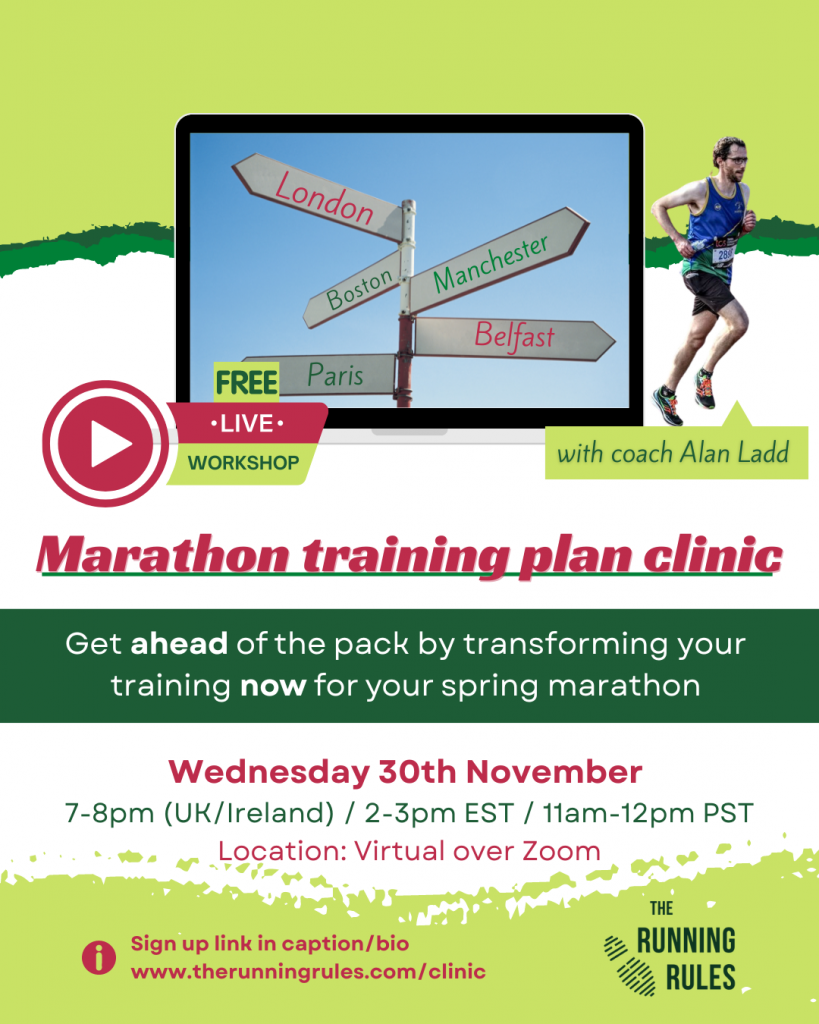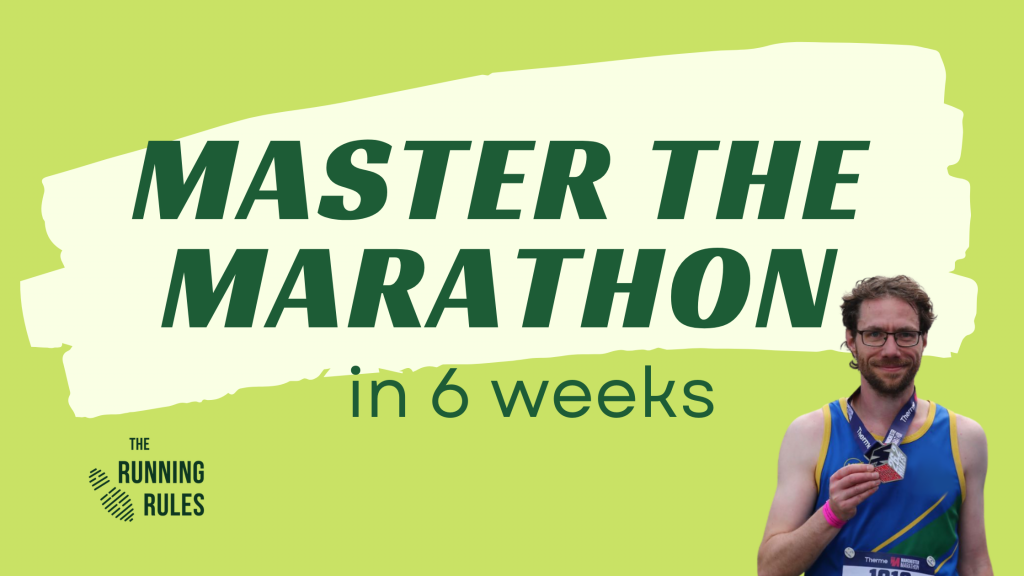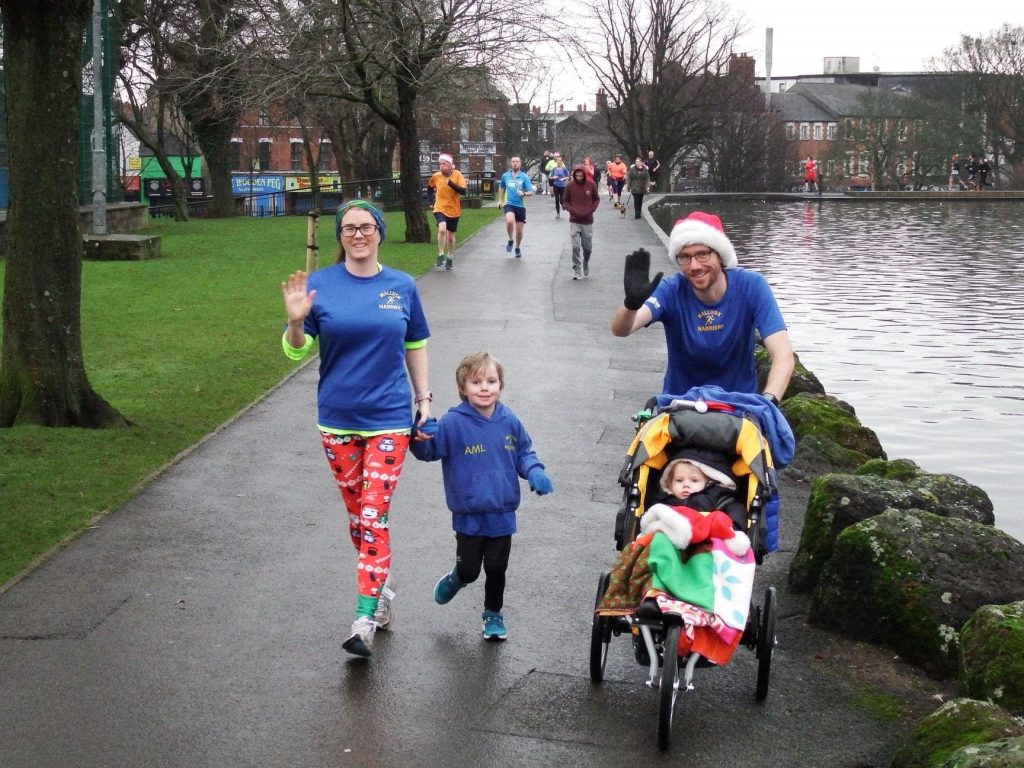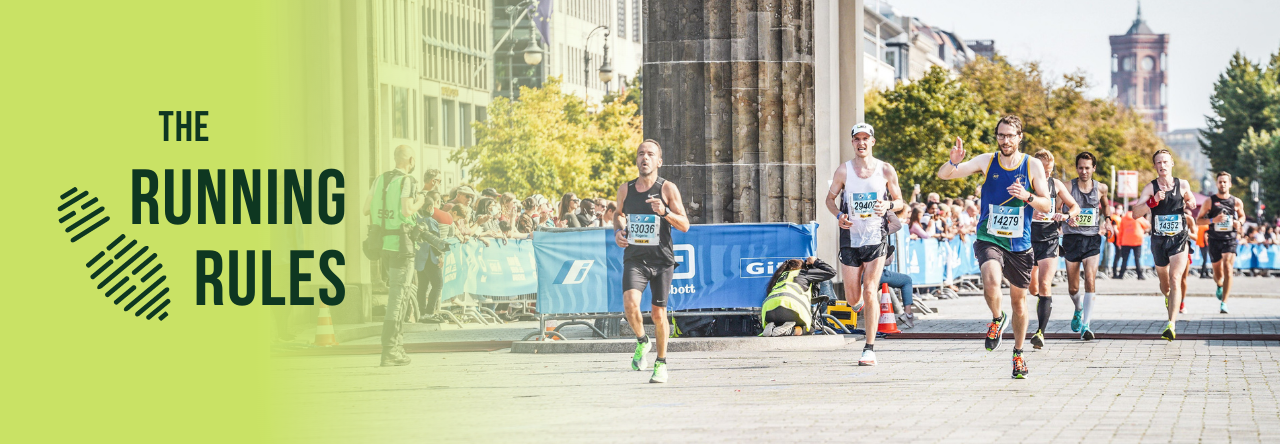
Category: Habit Page 1 of 2
Run faster, stronger and more confidently
Free running guides
Free nutrition guides
Free pacing planners
Free strava club
I’m very excited to share with you a brand new course to master your next marathon. I have a special beta offer on for enrollment until midnight Friday 1st July. To find out more – go to www.therunningrules.com/master-the-marathon.

Transform your training, nail your nutrition and master your mindset so that you can run marathons faster, stronger and more confidently
Push on from the middle of the marathon pack to fulfill the potential you know you have, outperform your fellow club runners, and qualify for major marathons.
“Master the marathon in 6 weeks”
is a course designed to run alongside your marathon training to teach you how to structure and execute training and the race itself, the importance of nutrition, mindset and lifestyle on your performance and how to implement these in an optimal and sustainable way for your life.
If you have any questions, please reach out to me at alan@therunningrules.com
The 5 pillars of running your greatest marathon

I’m so excited to be inviting you to learn what make up the 5 pillars of your greatest marathon race. There are going to be some quick wins you can start implementing straight away and take into your next race so this is perfect if you have an autumn marathon on the horizon. Even if you don’t, this will be valuable when you come to consider you next one. Sign up at www.therunningrules.com/pillars or use the link in the menu.

Injury is the word no runner wants to hear. It’s easy to think that if anything throws us slightly off plan then everything is lost. But the truth is that the plan is just a guide. There is no magic sequence of events that lead us to being our best and in fact, sometimes when the road ahead is blocked, another route opens up which gets us there quicker.
Illness
I had an interesting question this week:
“I tested positive (for Covid) and have had to miss a week of training already, just want to know do you think it’s still worth training for the marathon?”
This encapsulates the fear that if something doesn’t go 100% right then we won’t achieve the perfect outcome. But there will always be something that crops up that means we can’t do everything by the book. And I would argue that if it didn’t then we’re not as prepared to adapt and deal with whatever a race throws at us.
Unfortunately Covid cases are so rife now that avoiding it, especially with kids in school, seems to be a lottery. Thankfully, the severity for most seems to have reduced and the main inconvenience I hear these days is just the inability to get out to train due to self-isolation.
Of course if you are unlucky enough to suffer with bad symptoms which can linger on then the route back is going to be slower and you’ll need to tread more carefully but for most, a week off training is not going to have a massively detrimental effect especially over the course of a marathon training cycle.
So yes, absolutely it is worth carrying on with the training. In reality, you won’t have lost any fitness in a week and more likely than not, the rest will have done you some good.
My advice is simply not to go full throttle in the first session back and use the first week to ease back in. Don’t try to make up for the miles or sessions missed and you may need to adjust the next couple of weeks slightly just to reduce the load a little.
Medium term injury
I’ve been very lucky with (or maybe you could now say proactive against) injuries but the ankle injuries I sustained in 2018 and the back end of 2021 both required a month off running. They probably affected me in quite different ways but I certainly look back at the 2018 injury as a turning point in my running career.
Up to that point, I had never really had a serious injury but I’d also never really fully thrown myself into trying to be the best runner I could be. I’d achieved a few smaller running goals which I was pleased with but a sub 3 hour marathon seemed like a pipe dream. With a best of 3:25, I’d need to run a whole minute faster every mile.
However, I always felt like I had time on my side. The time hadn’t been ‘right’ and ‘one day’ I would give it a go. That changed during the month when I couldn’t run. I realised that you never know what is around the corner and that if I wanted to try and do it, there was no better time than when I had recovered from my injury.
The month off gave me a renewed appreciation of running and helped me not to take it for granted. I was far more consistent in my training and to my surprise I managed to run 2:58 later that year. I still put a lot of that down to changing my outlook while I was injured.
My latest layoff has been a little different. It happened when I was in the best shape I’d ever been, having just run a PB in Berlin despite difficult conditions. I felt if I could get to Manchester six months later in the same shape, I’d have a good chance of breaking that again.
However, what I realised through injury is that I’d needed a break all along. I wasn’t exactly loving running – the few months before had been the toughest I’d ever done. By the time I was able to run again, I couldn’t wait to get going.
Injury is a reminder of what I said before – you never know what is around the corner. I’m probably 6-7 weeks behind where I wanted to be at this stage but I’m remaining positive. I worked back really slowly after the injury and am feeling no ill effects.
I can feel my fitness is not where it needs to be yet but I still have 9 weeks and hopefully conditions will be on my side so that I may get close to that Berlin time. There are other goals to play for too like qualifying for Boston again which is pencilled in for 2023.
The takeaway here is that an injury can allow you to refocus on what is important. It can help you rediscover the joy of running and it can help you to change the way you approach it to get better results in the future.
Long term injury
For those that are unlucky to have a longer term injury of months or a recurring problem it must be very frustrating. Everything that I said above can still be true but it is also difficult to hold onto the hope that you will get past the injury and onto better things.
Working with a good physio has been invaluable to me. So many runners I talk to think that their injuries will get better or vanish simply with rest. And whilst rest can be good, it will not cure most problems.
Injuries are usually a result of a specific incident where damage has occured or long term problems caused by too much load on the body where it is too weak to cope. In both cases, focusing on the right ways to strengthen the body is key to being able to avoid problems in the future.
A good physio can not only tell you what you need to work on but help keep you accountable and also keep you realistic about your progress and expectations. My physio is great at focusing on what I can do rather than what I can’t do.
She also records my pain levels and frequency of pain so that she can give an objective opinion on my progress. Quite often our view of progress is subjectively clouded by our unrealistic expectations or even just our mood on the day.
Focus on what you can do. We are runners and that can mean that not being able to run seems like it’s not worth doing anything else. But maybe you can find something else you do enjoy. I’m not a keen swimmer but I went to the pool a few times and found it was still good for my mental health when I couldn’t run.
Maybe you can focus more on strength work in general. Maybe it’s a good time to start sorting your nutrition out (check out my free ‘Kickstart your nutrition guide’). Maybe it’s getting back to another passion you have in life like music or spending more time with friends and family.
Running won’t go anywhere. It is waiting for you when you are ready. If you have bucket list goals like running the London marathon for example, then keep focusing on that during your rehab. It will help you to put the work into getting back to where you need to be.
Reframe and rest
Whilst none of us like injury or illness, it is going to affect us all at some point so being prepared to reframe it in a positive way will help you absorb the shock when it does happen.
Best of all, can you pre-empt an injury and be bold enough to take a week or two off when you need to before an injury occurs? Listen to your body and don’t be afraid of taking a break. The rest will do you good and you won’t lose the fitness that you would with a medium to long term injury.
Stay fit, stay safe, stay running.
Have you fully committed to finding out what your potential is?

I’m 38 this month. Over the hill. Past it. Yet before I’m 40 I want to try and beat my 20 year old self by an hour in the marathon. Back then I was over the moon with my first marathon time of 3:41 and indeed for many years I was content that I could hang up my running shoes at any time with a solid marathon time to my name.
The numbers are arbitrary. Everyone is different. My 3:41 might be someone else’s 5:41. But having since run much faster than that I now know that I was scratching the surface of what was possible for me in that first marathon.
So how can a nearly 40 year old run so much faster than a 20 year old?
Steady vs sporadic commitment
I had always viewed the marathon as the culmination of 16 weeks of training. I’d book in a race then ‘commit’ to the training for the 16 weeks prior to the race. This is ‘sporadic commitment’. It assumes that each marathon and training block is a discrete period of time unrelated to anything else in your life.
The stop start nature of this way of thinking about training (“I’m either training for a marathon or I’m not”) made it harder to adhere to plans. I didn’t have a structure around my training the rest of the time so it felt unnatural during marathon training.
My body wasn’t used to it either and adding a lot of extra training stress without properly offsetting that with good nutrition meant I got colds as my immunity was lowered. I’d miss entire weeks of marathon training which, although is sometimes unavoidable, was hardly ideal.
Contrast that with the last 12 months where I haven’t been training for anything in particular but my training has been more structured and consistent than ever. I started viewing training as something that is a natural part of my life, not something that needs to be turned on or off.
This is ‘steady commitment’ and it can build over time if you allow it. At the start, you may not be able to commit to as much training as you think you need to get to where you want to be. But training accumulates over time so even committing to what you can now will help you in the long run.
Physical vs mental ability
We mostly think of ageing as a negative trait but as we get older we improve in many ways. When I ran my first marathon, I had youth on my side. I was also relatively fearless of the marathon. I didn’t know how hard it would be so I just gave it a shot.
But I now have much more experience of training and racing. I now know when and why things will get tough and how I can get through those situations.
You also learn over time. Your body might not be as young as it was but you learn to manage it better. You realise what you really want to focus on and learn the training techniques, recovery strategies and nutritional strategies to get you there
Your first marathon should not be your fastest. Unless it is your only marathon. You may not beat this time every time but with every marathon you build up more experience of things that went well and things that didn’t.
In every training block you should find new things to work on and build on your previous experiences. You should improve mentally over time.
There is one caveat to this: I said I wasn’t fearless when I was young. I was also not respectful of the distance and the challenge of a marathon. My next two attempts both ended pretty disastrously. I thought about quitting.
This is known as the dip and if you find yourself here you have to work your way out and not quit. If you find a way through, those bad experiences will help improve your future performances. I don’t regret those efforts. I wouldn’t have the bank of experience I have now if everything had always gone swimmingly.
You don’t know what’s round the corner
It’s easy to put things off. We don’t have time right now. Races aren’t on so what’s the point?
Yes there are some big life situations that might mean now is not the time to start committing to training but in most cases training can compliment whatever else is going on.
I took 18 months off running around the time of our first son and it was too long. When I started back it really felt like I was starting from scratch. However, I ran my first ultra less than 6 months after the birth of our second son.
Sometimes it’s easy to say ‘I’ll do it when’ but instead we can say ‘I’m going to start progressing towards that’. It doesn’t mean you’ll necessarily run your best marathon this year or next but you are starting moving towards the best that you can do.
And if you enjoy the process then it becomes addictive. You’ll want to see just how far you can go. If you don’t enjoy what you are doing then it’s at that point you should change things up or focus on something else.
You may not love running forever so why not do the best you can now while you do?
7 ways to find consistency with your running

Most things in life take time to get good at. They take dedicated practice. Yet most of us can run without any practice because we learnt the skill when we were young. Because of this, sometimes we choose to believe there are ‘natural’ runners out there and that we have a limited given skill level.
However, we all have the ability to improve greatly through consistent practice. Our fitness improves and so does our technique. We build mental resilience too which is a vital component to running success.
But what does consistency look like? Do we have to be running every day of the week? Do we need to be running 100 miles a week?
What is our potential?
We all have a potential which far exceeds what we’ll ever actually achieve. Even elites may never quite accomplish what they are physically capable of because so many things have to fall into place for a ‘perfect’ outcome.
Just think what lengths Eliud Kipchoge had to go to to break the 2 hour marathon mark. It was physically possible for him but only by optimising his environment with pacers that shielded the air resistance.
Mere mortals like us will never get close to what we could achieve because most of us do not have the time, money or inclination to train as elites would do. We have jobs, families and other commitments.
However, we can achieve a more limited potential that is still much higher than most of us believe. It is governed by how much time and effort we want to commit to it.
Initially, the returns from a relatively small time investment can be huge. After a while, it takes a lot of extra time for small gains so it becomes a question of how far you want to go.
But whatever level of commitment you choose, being consistent week to week speeds up your progress and minimises your risk of injury. The latter is possibly one of the biggest barriers to runners achieving their goals. So how do you get consistency?
Don’t overcommit yourself
The temptation can be to stretch yourself too much at the start. This can either be due to what you think is required to be successful or by watching what others do. I now run 6 days a week every week but that has been built up slowly over years of running 3 then 4 then 5 days a week.
Choose something that is easy for you to achieve. If 3 days seems like a lot, could you run 1 or 2 days at the start? If an hour is too much, could you do 20 or 30 minutes of running each time?
You can always add more days and more minutes to your weeks in the future. The key is to get started with something that you can manage right now.
Put your plan where you can see it
Make yourself a plan by factoring in your weekly commitments and fit your training around them. Preferably, you can find the same slots every week that you will be able to do your training in. If not, then it is even more important to plan.
Make sure you can see your plan especially in the early days. It is easy to forget to do a session at the start if you don’t have a visual prompt. And if you miss one, that’s when you can miss more and the whole plan falls by the wayside.
Print your plan out and stick it where you will see it every day. Maybe in your bedroom, or on the fridge or next to your desk at work. Do it where you need the prompt.
Alternatively, if you are more in favour of a digital reminder, add it to your calendar or add it to your reminders. Again, time the prompts to when they will have the most effect.
Make it easy
Structure your training at times which will give you the most chance of completing it. If you know you only have an hour window at lunchtime between two important meetings then it might be better to plan to do it earlier or later in the day.
If you know that you’re usually tired after work and not in the mood for a run then try and go before work.
Have your gear ready to go where and when you need it. There’s nothing worse than rooting around to try and find a pair of running socks or gloves if you’re in a hurry. If you’re running from somewhere other than home, be sure to check the weather and take everything you’re likely to need, preferably packing your bag the night before.
If food for after your training is an issue (for instance if you’re running at work), make yourself a lunch or snack the night before so that you don’t have to cut your run short to get food from somewhere else.
Work towards something
Consistency is much easier if you’re working towards a goal. The goal could be a race or time trial, a new distance or it could be simply adhering to your plan. In fact it can be useful to have both outcome goals and process goals.
An outcome goal is simply what you want to achieve at the ‘end’ of the training. The ‘end’ here could be a literal end if you decided not to continue running but is more likely to be the end of a block of training.
This could be running a certain distance, or a certain time for a distance. It could be achieving a certain weekly time or distance goal.
A process goal is almost more important. It is what you want to achieve week to week with your training. Sometimes this can be less tangible but it could be along the lines of enjoyment, keeping your consistency going or a weekly improvement in some area.
If we only ever focus on the outcome then it can make week to week training much harder and also increase the disappointment if we don’t quite make our outcome goal.
Keep challenging yourself
As alluded to, having some goals will help maintain your consistency. However, a lot of people respond best when they are challenged. If you set all your goals to be very easy then it is possible to become disinterested.
Find new ways to keep your training interesting and challenging. Don’t be afraid to push the boundaries of what you can do as long as you build to it sensibly and within the framework of your training.
Build new training stimuli like elevation, new terrain, more distance and more intensity slowly into your training but keep reviewing which areas you would like to change and improve on.
But you need to ‘win’ as well
You can’t keep pushing all the time. That can lead to overuse injuries and becoming burnt out. Remember to keep a high proportion of your training easy. Have some down weeks to recover physically and mentally.
You don’t always have to be on the edge of your capabilities even in harder sessions. Sometimes, accomplishing a session whilst feeling you had a little more to give can be a powerful mental tool for future sessions.
If you are constantly struggling in every session it will sap your enjoyment and increase your doubts of your own abilities. Find a balance to your training that is challenging but where you are able to prevail more often than not.
Keep enjoying what you’re doing
Ultimately, you can follow everything above but if you are not enjoying your training your consistency will wane in the end. Hopefully following everything above will sustain both your enjoyment and your consistency.
Of course there will always be the odd session that didn’t go to plan or you didn’t feel 100% on but if that is happening more often than not then you need to change something up. Go back through the list. Is your training sustainable, working towards a goal, challenging but also manageable?
By staying consistent with your training you greatly reduce the risk of injury caused by sporadic high and low mileage weeks. You will also raise your base fitness to a much higher level allowing you to build and excel at your running in the future.
Why most of us are constantly underachieving

It’s the time of year we like to set new goals and look forward to the future. We think about all the things we ‘did wrong’ last year and sometimes we might consider what went right too.
What are your goals for this new year? How did you arrive at them? Is there a burning desire to achieve something or did you just feel like you should set something to do?
How ambitious are your goals? Did you set something outside of your comfort zone or are you playing it safe? Are you worried what people will say if you fail?
Why are we afraid to push our boundaries?
Most people are afraid to think big. It has been ingrained in us at an early age that we shouldn’t fail. (Actually I’m pleased to say that this is a message that has started to change in schools. At my son’s primary school they do talk about reframing failure as a learning opportunity).
But for me and for many, the emphasis was always on ‘good results’ and ‘staying out of trouble’ and ‘conforming to the expected norm’. The result is that most people lead average lives putting an average amount of effort into everything and thinking that we’re only capable of average.
That belief coupled with worrying what other people think if we try and do something out of the ordinary leaves us too scared to try something radically new. Yet the reality is that because so many people think like this, it isn’t as hard as you think to do something more extreme.
Your ‘why’ has to be strong
If you don’t have a strong reason for doing something then it will be difficult to follow through with it. People’s reasons for doing things vary greatly and can be very personal. They might also not be immediately obvious. You might have to ask ‘why’ several times before you find the root reason.
For example: I want to run – why – to complete a marathon – why – to raise money for charity – why – because it is a cause I believe in strongly – why – because a member of my family suffered from the disease and I want to help others in that situation.
A strong reason will help you battle through when things get tough.
How big should the goal be?
The size of the goal is going to be very individual too. The goal of running a marathon might feel a very long way off for someone new to running but it wouldn’t be a big challenge for me without adding a strict time element. Conversely, a 100 mile race would be a big challenge for me but not for accomplished ultramarathoners.
Fitness entrepreneur Brian Keane says you should pick a goal that feels a little over what you think you could reasonably achieve. I agree with this. It needs to be something that you would absolutely love to achieve but also not something so wild that you will quickly get discouraged.
You have to be completely honest with yourself when assessing this. The context is key too. It is absolutely possible for many people to drop their marathon time by 30 minutes or more because their training has never been ideal. It would be very hard indeed for me to drop 30 minutes.
It can be tempting to play it too safe. Time goals especially lend themselves to this. It could be far more compelling to go for a sub 4 hour marathon than a sub 3:50 marathon but the latter might be the right goal for you to really get the best out of yourself. The sub 4 will come for free.
Tell people your goal
It is scary to pick a goal that you might fail at. But failure doesn’t need to be the end of the story. You can tweak things and go back and try again or you can change course to something else more suited.
Unless you are very strong willed it is a good idea to make your target public or at least tell people close to you. It gives an extra incentive to keep going when things are difficult. It also stops you backing out if you start doubting yourself.
In the extreme case, people will tell you that you can’t or shouldn’t do something. If your reason is strong enough, you will use this as fuel to prove them wrong and do it anyway. That’s precisely what happened to me in 2017.
What does an ‘unrealistic’ goal look like?
In 2017 I decided to run 24 parkruns (5k routes) across Northern Ireland in 24 hours. I was inspired by Eddie Izzard’s 27 marathons in 27 days in South Africa (in my opinion a much more impressive feat).
I was told by numerous people that it couldn’t be done. And they had good reason to doubt me. I’d never run more than a marathon, logistically it seemed a nightmare and to be completely honest, I didn’t know if I could do it myself.
Once I said I was doing it publicly I knew I couldn’t change my mind. I was going to do it or crash spectacularly trying. But those doubting voices including my own added fuel to the fire.
My ‘why’ was strong. I was doing it in tribute to my late Mum, a marathoner and inspiration for my own running whilst raising money for charity.
I chose the challenge because it was different to anything other people were doing and anything I’d done before. I didn’t want to ‘play it safe’ and it also made me feel more confident asking for sponsorship!
So many people got on board with it in terms of running, organisation and sponsorship which made it a huge success raising over £10000. I am indebted to all those people but I do think the project appealed more because it was quite extreme (for me at that time).
What does ‘unrealistic’ mean to you?
Reevaluate your own goals for 2021. You don’t have to go as extreme as I did in 2017 (I haven’t myself) and it is all relative but could you push your targets a bit more?
If you plan to run a 5k – could you run a 10k? If you are targeting a 5 minute PB in the marathon, could you make it 10 minutes? If you want to raise £1000, could you raise £2000?
Choose something that makes you feel uncomfortable and start achieving!
Enjoy yourself and stay on top of your health this Christmas

Like many, it will be a very different Christmas for us this year. We won’t see any other family and we’re even opting for afternoon tea instead of a Christmas dinner. There won’t be the annual rush to get out of the door and down to the parkrun start line on time!
I know many will face tougher Christmasses than us and I extend my best wishes to you all especially this year. Keep your body and mind active and stay healthy.
We will be heading out for a run/walk on Christmas morning. It will be the first time in 7 years I haven’t done the parkrun but the coach has a run in the plan and it’s always good to get out early and enjoy the rest of the day in the warm.
It’s tempting to fall off the wagon completely at this time of the year in many aspects. Suddenly it’s colder outside and those runs don’t seem as appealing. Our diet can fall by the wayside because there are more ‘treats’ lying around that can sneak their way in.
New year is just round the corner which seems like the perfect opportunity to pick up the pieces but it can be harder than it needs to be depending on how far we’ve let it slide.
Last year I purposely took 2 weeks off running. I’d just run a marathon at the end of November and I felt I needed a little break. But I didn’t replace it with anything. No walks round the block, no cycling or swimming.
And I’m also the type of person that cannot resist an open bag of doritos, a tub of quality street or a social drink. Visiting family and friends at Christmas always turned into too much food and drink for a few days in a row.
I remember it taking a few weeks of marathon training in January to start feeling like I was getting back into shape again. It was tough to get going again even with the cross country season in swing and Boston marathon to look forward to.
That’s not to say that Christmas time shouldn’t be enjoyed. You should absolutely have the best time you can – we deserve it this year more than any. But there are ways to mitigate how much work it will take in January to get into shape. We don’t have to let it slide till then.
Try and maintain your regular running schedule. If you can’t do that or want a little break then why not go for a walk instead? Take the kids round the lights in the neighbourhood at night. I think people have made more effort with decorations than usual this year and we were out for half an hour last night.
Enjoy the food and drink but think twice about digging in the tub for more and more chocolate. If I wasn’t paying attention I would just keep eating if something is out on the table. Limit the amount of ‘nibbles’ you put out and ideally limit the amount in the house! We always buy more than we need.
Better still try and opt for healthier nibbles such as veggie sticks. Use dips if you like, overall they’re still going to be a lot healthier than bowls of crisps.
Use the time now to think about your goals for 2021. It’s tempting to switch off entirely and wait till the 1st of January to wave the magic wand but if you have time off round Christmas, it‘s a great time to reflect on the year and start planning ahead.
January comes round very quickly and before we know it we’re back at the grind with Christmas a distant memory and we haven’t got a proper handle on what we’re doing next.
A walk or a run can be a perfect time to get out and think about this year and next. Are you happy with where you are and what you are doing? What areas of your life could be improved? What could you start doing to address that area?
Enjoy Christmas and a massive thank you for reading and supporting my articles. Please let me know if there are areas you’d like me to write about more by emailing me or DM on social media. See you all in 2021!
Why a ‘bad’ training session can be great in the long run

Anyone who has run for any length of time has had one. A training session that sucked. The paces were all off or you felt sluggish or maybe your brain was telling you you couldn’t do it. You were left wondering why you even bother.
I have them from time to time and it is frustrating. We want to be able to smash everything that is thrown at us – be an A* student all the time. But even though I’ll still be disappointed, I’ve started looking at these types of sessions more pragmatically.
You’re not a robot
One thing I’m realising more and more through studying nutrition is that the body is an amazingly complex thing. And day to day it’s affected by far more than just your current ‘fitness level’.
Sleep, diet, hydration, stress and mindset can all play a significant role in running. Add that to external factors such as terrain and conditions and there is no valid way of determining exactly how you should and will perform on any given day.
Just because you run at a certain pace one week, it doesn’t mean that you can and will the next week. We can’t set all the factors up exactly the same each time so let’s not beat ourselves up about being slightly slower one week.
Tracking devices are not accurate
‘Your running watch is wrong!’. I heard this quote at a talk once and it made me smile. I, like many others, think of our watch readings as the holy grail of tracking. A second per mile here or there, a particular heart rate reading or that extra .01 mile you do for Strava are all vitally important.
However, the truth is that there is an element of inaccuracy in all of them. Some can be better than others but there is no way to know exactly how accurate they are at any particular time. So again, let’s not get disheartened over a few seconds here and there when we don’t know if the distance is accurate.
You’re more fatigued in training
I’ve consoled myself with this on many occasions. If your training plan is set up correctly, you should (usually) be able to muster up a better performance on race day as there will be an amount of tapering that will have you optimally rested.
Of course you should have rest days built into your plan but you may still be doing some high intensity training two days after a long run. You’re unlikely to be doing a race two days after a long run.
You’re also more likely to (and should!) prioritise sleep, hydration and diet more in the days leading up to a race whereas you may not have time or the inclination to make it a big priority during a training cycle (though you should certainly still try to).
You’re training at the right level
If I sailed through every training session smashing all the paces then I’d probably be very satisfied with myself. Until I asked the question – why is this training so easy? Should I be pushing myself harder? What am I really capable of?
I know when I coached myself that sometimes I would let myself off the hook in a session. Nobody else would care about my pace so only I would know. But now with a coach, there is nowhere to hide. And sometimes I will ‘fail’ in my own eyes.
But doing so is a confirmation that the training is pitched at the right level. I have a good amount of success with it but it is challenging. If I failed to hit the paces any of the time then the training set would be too difficult.
Draw on the ‘bad’ experience in races
Some of those sessions stick in your mind for various reasons. But you can use them in a positive way to get through difficult patches in races by focusing on how you overcame them. Pair them up with good sessions and see how you progressed over time.
Sometimes I like to imagine one of those bad sessions in a race and think ‘at least this isn’t as bad as that!’. It could be extreme weather conditions or a niggle that you were carrying or just bad circumstances around a particular run.
There are no ‘bad’ runs
Ultimately, every experience shapes you as a runner and person. There are no ‘bad’ runs. There are challenging circumstances and we find a way to deal with them. Maybe not there and then but over time.
If you shy away from ‘bad’ sessions then you lose some of this experience. That doesn’t mean to say we can’t strive for perfection but that if things do go slightly awry, we learn from those situations to make us better runners.
